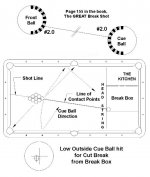I'm really good at racking 9-ball. I learned a technique that allows me to rack them super tight and make the corner ball practically every time.
Despite my racking abilities, I cannot figure out how to play position for a shot on the one ball on a bar box. I've watched plenty of Corey Deuel videos where he leaves himself a shot on the one in the side but I can't seem to reproduce it without leaving a huge cluster at the foot of the table.
I think the difference is that Corey is using a racking template which explodes the balls a little more than a wooden rack. Also, he's playing on newly setup tournament tables which are likely faster than the tables I play on. So his balls spread much better with a softer break. In order to get the same spread on my tables I need to hit the break slightly harder which leaves the one in a poor position.
I've tried breaking at soft, medium, and medium-hard speeds and I just can't seem to get a good leave on the one. I've also tried changing my cue ball position slightly but if you move it too much the wing ball no longer goes in. Additionally, I've tried adjusting the spin on the cue ball from high to low and everywhere in between which affects the direction of the one ball but still, no good results. I've never really messed around with side spin, maybe I'll try that next.
So far, the only thing that works is if I use extreme draw with a medium-soft speed to draw the cue ball to the head rail and back to the center of the table for a shot on the one in the side. This is not practical since it's too easy to scratch. Plus a lot of times I end up with a backcut on the one forcing me to send the cue ball around the table and into traffic.
The other thing that works is if the balls are racking a little looser than usual and I am able to position the cue ball a diamond length off the side rail when breaking. In this case the one usually comes down toward the corner pocket at the head of the table and is easy to play position for.
With a typical tight rack I usually break on the line from the corner pocket to the head ball. With an extremely tight rack I break from the side rail but the balls rarely rack tight enough for the side rail break. This is the other difference between my break and Corey's.
Can anyone give me a few pointers? Does anyone know of any videos where players are using wooden racks on bar tables and consistently playing good position on the one?
Thanks guys, have a Happy Thanksgiving! My favorite time of year for pool
Despite my racking abilities, I cannot figure out how to play position for a shot on the one ball on a bar box. I've watched plenty of Corey Deuel videos where he leaves himself a shot on the one in the side but I can't seem to reproduce it without leaving a huge cluster at the foot of the table.
I think the difference is that Corey is using a racking template which explodes the balls a little more than a wooden rack. Also, he's playing on newly setup tournament tables which are likely faster than the tables I play on. So his balls spread much better with a softer break. In order to get the same spread on my tables I need to hit the break slightly harder which leaves the one in a poor position.
I've tried breaking at soft, medium, and medium-hard speeds and I just can't seem to get a good leave on the one. I've also tried changing my cue ball position slightly but if you move it too much the wing ball no longer goes in. Additionally, I've tried adjusting the spin on the cue ball from high to low and everywhere in between which affects the direction of the one ball but still, no good results. I've never really messed around with side spin, maybe I'll try that next.
So far, the only thing that works is if I use extreme draw with a medium-soft speed to draw the cue ball to the head rail and back to the center of the table for a shot on the one in the side. This is not practical since it's too easy to scratch. Plus a lot of times I end up with a backcut on the one forcing me to send the cue ball around the table and into traffic.
The other thing that works is if the balls are racking a little looser than usual and I am able to position the cue ball a diamond length off the side rail when breaking. In this case the one usually comes down toward the corner pocket at the head of the table and is easy to play position for.
With a typical tight rack I usually break on the line from the corner pocket to the head ball. With an extremely tight rack I break from the side rail but the balls rarely rack tight enough for the side rail break. This is the other difference between my break and Corey's.
Can anyone give me a few pointers? Does anyone know of any videos where players are using wooden racks on bar tables and consistently playing good position on the one?
Thanks guys, have a Happy Thanksgiving! My favorite time of year for pool
Last edited:

